The New Elegance
The Renaissance of fashion graphics
Gerd Grimm – Fashion artist (1911 – 1998)
(Dirk Schindelbeck)
 For decades fashion graphics seemed to be an outdated art. But then in 1989 a retrospective exhibition was dedicated to René Gruau (1909 – 2004) - graphic artist for Christian Dior - in the Musée de la Mode et du Costume in Paris and the interest in fashion graphics started to rise again. The exhibition not only presented a graphic designer’s profile and quality to a wider audience “but also documented the evaluation of fashion and its illustration as art” (Birgit Liesenklas). Today, one can speak of a small Renaissance in fashion graphics.
For decades fashion graphics seemed to be an outdated art. But then in 1989 a retrospective exhibition was dedicated to René Gruau (1909 – 2004) - graphic artist for Christian Dior - in the Musée de la Mode et du Costume in Paris and the interest in fashion graphics started to rise again. The exhibition not only presented a graphic designer’s profile and quality to a wider audience “but also documented the evaluation of fashion and its illustration as art” (Birgit Liesenklas). Today, one can speak of a small Renaissance in fashion graphics.
 As early as the 90s, fashion graphics gradually appeared again in advertising. As Donald Schneider, art director at Paris Vogue has noticed, the audience always prefers to see the real garment, for which photography seemed to have been an adequate tool for decades. “However, if it comes to expressing an attitude or style, drawings are just as effective a communication tool. And since this art has been neglected for such a long time, it now has this fresh and pristine effect, almost like a ‘manner of representation’”.
As early as the 90s, fashion graphics gradually appeared again in advertising. As Donald Schneider, art director at Paris Vogue has noticed, the audience always prefers to see the real garment, for which photography seemed to have been an adequate tool for decades. “However, if it comes to expressing an attitude or style, drawings are just as effective a communication tool. And since this art has been neglected for such a long time, it now has this fresh and pristine effect, almost like a ‘manner of representation’”.
Of course, fashion drawings are first and foremost about clothing, but this does not mean they are limited to ‘fabrics’ only. A fashion drawing also captures attitude, life style and atmosphere, be it without background, in deliberately fashionable surroundings or just merely hinted at. A fashion drawing is evocative and stimulating. From that point of view, fashion presents itself as romantic fiction, which amazes, enchants, and tempts us as visual luxury.
A fashion graphic artist from Germany
Like fashion itself, fashion graphics is a global phenomenon prospering in the big fashion centres such as Milan, New York or Paris. Above all, Paris, with its Haute Couture, has always provided ideal conditions as genius loci. Only here could René Gruau, together with Christian Dior become eminent and rise to fame.
Gerd Grimm never had these ideal surroundings, although he can be called one of the masters of this discipline – alongside George Lepape, Paul Iribe, Jean Patou or Elsa Schiaparelli. Within German-speaking countries he was seen as a singular phenomenon. Already in 1951, Eberhard Hölscher wrote in the journal “Graphik”, that Grimm “belonged to the very few German fashion graphic artists who moved with assurance in international circles.” And the fashion graphic artist Gi Neuert admitted: “We admired his brushwork, his elegance and his ease.” Nevertheless, Gerd Grimm is still almost unknown to the wider public. Why is this?
Modest and workaholic
The answer lies both in his personality and in the historic situation of 20th century Germany.
Gerd Grimm worked like a maniac, he drew and portrayed ten hours a day, in every situation and at every occasion – taking motifs
 from television, sketching portraits of politicians or writers on a sheet of paper within minutes. He told friends, he needed this to keep fit and to preserve his brush-stroke. Grimm produced incessantly, but he never liked to show off. He lived a modest and secluded life together with his wife, son, and dog in his house-cum-studio in Freiburg, which overlooked the river Dreisam and the Black Forest. He invariably took his commissions over the telephone.
from television, sketching portraits of politicians or writers on a sheet of paper within minutes. He told friends, he needed this to keep fit and to preserve his brush-stroke. Grimm produced incessantly, but he never liked to show off. He lived a modest and secluded life together with his wife, son, and dog in his house-cum-studio in Freiburg, which overlooked the river Dreisam and the Black Forest. He invariably took his commissions over the telephone.
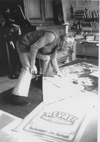
 The only way he made publicity for himself was by large-format calendars with his portraits of young women which were sent to 150 selected recipients. For 40 years – between 1960 and 1999 – these graphics, known as “Grimms Mädchen” (“Grimm’s young women”), were in great demand. These few activities prove again why he shunned publicity. This caution was only partly due to his personal disposition, it was also the result of bad experiences during the Nazi regime. Gerd Grimm was a so-called ‘Half –Jew’. In order to survive it was important not to attract attention, even to hide, hardly ideal conditions for an artist of his standing.
The only way he made publicity for himself was by large-format calendars with his portraits of young women which were sent to 150 selected recipients. For 40 years – between 1960 and 1999 – these graphics, known as “Grimms Mädchen” (“Grimm’s young women”), were in great demand. These few activities prove again why he shunned publicity. This caution was only partly due to his personal disposition, it was also the result of bad experiences during the Nazi regime. Gerd Grimm was a so-called ‘Half –Jew’. In order to survive it was important not to attract attention, even to hide, hardly ideal conditions for an artist of his standing.
Surviving as a "Half-Jew" under the Nazi regime
Gerd Grimm was just 22 years old when the Nazis gained power in 1933.
 He had recently finished his art studies at the academies of Karlsruhe and Berlin (his professor was among others O.W. Hadanck), where he had also met his lifelong companion and later wife Hilde van Gülick (an equally gifted graphic artist and during his lifetime his unerring critic).
He had recently finished his art studies at the academies of Karlsruhe and Berlin (his professor was among others O.W. Hadanck), where he had also met his lifelong companion and later wife Hilde van Gülick (an equally gifted graphic artist and during his lifetime his unerring critic).
 Grimm's appearance on the scene as a fashion artist seemed very promising. He received his first orders for title-pages of great fashion magazines such as “Silberspiegel”, “Die Dame” or “Elegante Welt”. In addition to that he delivered artwork for cigarette brands such as Muratti Ariston or Reemtsmas Ova, and Scherks facial lotion, or Kupferberg sparkling wine. Several drawings for title pages are documented from that time - drawings which he had produced together with Hilde such as the 1933 April issue of the avant-garde journal "die neue linie". However, with the announcement of the so- called Nuremburger racial laws ( “Law for the protection of German blood and German honour“) in September 1935, Gerd Grimm – now labelled a “Half-Jew“ – realised that he had hardly any opportunities in Nazi Germany anymore.
Grimm's appearance on the scene as a fashion artist seemed very promising. He received his first orders for title-pages of great fashion magazines such as “Silberspiegel”, “Die Dame” or “Elegante Welt”. In addition to that he delivered artwork for cigarette brands such as Muratti Ariston or Reemtsmas Ova, and Scherks facial lotion, or Kupferberg sparkling wine. Several drawings for title pages are documented from that time - drawings which he had produced together with Hilde such as the 1933 April issue of the avant-garde journal "die neue linie". However, with the announcement of the so- called Nuremburger racial laws ( “Law for the protection of German blood and German honour“) in September 1935, Gerd Grimm – now labelled a “Half-Jew“ – realised that he had hardly any opportunities in Nazi Germany anymore.
Even though it was theoretically possible for Jews to continue working until the pogrom night in November 1938, they were increasingly eliminated from public functions and driven out of cultural life. In October 1935, shortly after the announcement of the racial laws, Grimm decided to start a new life in France (Le Havre, Paris). Bad experiences with some of his customers there made
 him return to Berlin that summer. Here he set up a studio as a freelance graphic artist.
When pressure on Jewish citizens gradually increased at the end of the 30s, Grimm emigrated a second time, this time to the UK.
And again, he came back to Germany. Grimm managed to get his drawings printed and paid only with the help of his “Aryan” girl-friend Hilde and friendly publishers – his signature could hardly be identified. In those years Gerd Grimm cultivated his deep anxieties against public appearances, which also determined his later life.
him return to Berlin that summer. Here he set up a studio as a freelance graphic artist.
When pressure on Jewish citizens gradually increased at the end of the 30s, Grimm emigrated a second time, this time to the UK.
And again, he came back to Germany. Grimm managed to get his drawings printed and paid only with the help of his “Aryan” girl-friend Hilde and friendly publishers – his signature could hardly be identified. In those years Gerd Grimm cultivated his deep anxieties against public appearances, which also determined his later life.
Although Grimm was considered to be "non-Aryan", he had to join the Wehrmacht in September 1939 (see Brian Mark Rigg: ‘Hitler’s Jewish soldiers’), but got his demission in June 1941 being considered “wehrunwürdig” (ineligible for military service). However, he never gave away his military documents and kept them in a safe place; he knew that these documents could save him from the Gestapo when travelling from his home in Berlin to visit his relatives in Freiburg and the Black Forest. Approximately a thousand times he travelled back and forth, and repeatedly he could hide for weeks in a small cottage in the Black Forest.
New perspectives after WW II – in the USA
Once World War II was over, Grimm no longer had problems with his half-Jewish origin.
 If you look
If you look
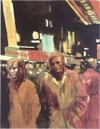 through Grimm’s graphic works of this period – between 1945 and 1951, you will notice an immense productivity, almost like an unleashed desire to start all over again in an open atmosphere with no restrictions. Now, in the immediate post-war period and long before the monetary reform, his talent exploded. Whenever pictures of beauty, elegance, style and urban flair appeared in Germany at that time, they surely originated from him. The title pages of the fashion journal “Die Frau” alone, which existed between 1946 and 1950, give some insight into his and his partner’s innovative presence. Of the 90 title pages which were published before the end of 1950 Grimm alone contributed 61! In addition, he provided countless graphics for the back cover and time and again
through Grimm’s graphic works of this period – between 1945 and 1951, you will notice an immense productivity, almost like an unleashed desire to start all over again in an open atmosphere with no restrictions. Now, in the immediate post-war period and long before the monetary reform, his talent exploded. Whenever pictures of beauty, elegance, style and urban flair appeared in Germany at that time, they surely originated from him. The title pages of the fashion journal “Die Frau” alone, which existed between 1946 and 1950, give some insight into his and his partner’s innovative presence. Of the 90 title pages which were published before the end of 1950 Grimm alone contributed 61! In addition, he provided countless graphics for the back cover and time and again
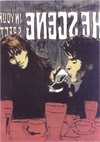 Hildegarde van Gülick added fashion graphics to the journal. Some of the title pages are characterized by great sophistication, for instance when Grimm skillfully repeats his graphic of the front cover in the background of a Valmeline ad on the back cover.
Hildegarde van Gülick added fashion graphics to the journal. Some of the title pages are characterized by great sophistication, for instance when Grimm skillfully repeats his graphic of the front cover in the background of a Valmeline ad on the back cover.
And yet, Gerd Grimm felt the need to cross the Atlantic and go to New York in the summer of 1950, shortly after the outbreak of the Korean War.There his talent seemed to be much in demand and customers such as Haarper’s Bazaar, Vogue, Esquire and other US-magazines were easily found.We are tempted to ask what would have happened to Gerd Grimm, if he had stayed in New York? However, New York was not the right place for his wife; she felt homesick, and so the couple went back to Germany in 1950.
A graphic designer in West Germany- country of the “economic miracle”
 Back in Germany the couple bought a house. In 1952 their son Sebastian was born handicapped. Meanwhile things in Germany had changed for the better, although in comparison to international standards and especially to the USA, the level in graphic design was still quite low. Nevertheless, Grimm drew for companies producing swimming-suits and nylon stockings, perfumes, cigarette brands such as Reemtsma and “Black and White” Whisky.
Back in Germany the couple bought a house. In 1952 their son Sebastian was born handicapped. Meanwhile things in Germany had changed for the better, although in comparison to international standards and especially to the USA, the level in graphic design was still quite low. Nevertheless, Grimm drew for companies producing swimming-suits and nylon stockings, perfumes, cigarette brands such as Reemtsma and “Black and White” Whisky.
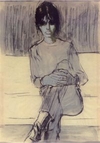 He also designed illustrations for publishers such as Fischer or Deutscher Bücherbund producing cover-motifs for novels by Thomas Mann, Arthur Schnitzler, Thornton Wilder or Boccaccio. Soon the news spreads of Grimm’s capabilities and achievements as the only German fashion graphic designer working on an international level. The Faller calendars with Grimm portraits of young women mentioned before are particularly well received and add to his reputation. Thus from about 1960 the style of his models begins to change.
He also designed illustrations for publishers such as Fischer or Deutscher Bücherbund producing cover-motifs for novels by Thomas Mann, Arthur Schnitzler, Thornton Wilder or Boccaccio. Soon the news spreads of Grimm’s capabilities and achievements as the only German fashion graphic designer working on an international level. The Faller calendars with Grimm portraits of young women mentioned before are particularly well received and add to his reputation. Thus from about 1960 the style of his models begins to change.
In the late 40s and 50s he had focussed on “dames en grandes robes”, meanwhile he preferred a younger, fresher type of model. But Grimm always refused to work with professional models. He didn’t like their artificial way of moving and behaving. As models, he preferred female students from Freiburg. But it was not he himself who acquired dozens of young ladies, his wife Hilde was the one who went out on the campus asking the young women whether they would like to model for her husband. From the early 60s, Grimm’s portraits of young women resemble a graphic illustration of what is known as the “Fräuleinwunder”.
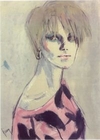 Thanks to the successful "Grimm’s Mädchen" the economic situation of the Grimm family improves, although the conditions for advert-graphics in general and in particular for fashion graphics became more difficult in Germany in the 60s.
Thanks to the successful "Grimm’s Mädchen" the economic situation of the Grimm family improves, although the conditions for advert-graphics in general and in particular for fashion graphics became more difficult in Germany in the 60s.
 In the first half of the 20th century, graphics had been the only adequate means of depicting a certain idea of fashion. Now, the emerging style of photo-realism was threatening to take over. And besides, some of Grimm’s practices did not seem up to date anymore. When times were bad for him he had become used to working only with low quality paper because he thought it was best for his ink drawings. He did not want to give up this habit even when much better paper qualities had long since become available. Also, he persistently refused to transpose figures and letters into graphics. And, of course, he remained a loner throughout his life. This was rather unusual at a time when advertising agencies were shooting up like mushrooms in Germany.
In the first half of the 20th century, graphics had been the only adequate means of depicting a certain idea of fashion. Now, the emerging style of photo-realism was threatening to take over. And besides, some of Grimm’s practices did not seem up to date anymore. When times were bad for him he had become used to working only with low quality paper because he thought it was best for his ink drawings. He did not want to give up this habit even when much better paper qualities had long since become available. Also, he persistently refused to transpose figures and letters into graphics. And, of course, he remained a loner throughout his life. This was rather unusual at a time when advertising agencies were shooting up like mushrooms in Germany.
Thanks to the successful "Grimm’s Mädchen" the economic situation of the Grimm family improves, although the conditions for advert-graphics in general and in particular for fashion graphics
became more difficult in Germany in the 60s. In the first half of the 20th century, graphics had been the only adequate means of depicting a certain idea of fashion. Now, the emerging style of photo-realism was threatening to take over. And besides, some of Grimm’s practices did not seem up to date anymore. When times were bad for him he had become used to working only with low quality paper because he thought it was best for his ink drawings. He did not want to give up this habit even when much better paper qualities had long since become available. Also, he persistently refused to transpose figures and letters into graphics. And, of course, he remained a loner throughout his life. This was rather unusual at a time when advertising agencies were shooting up like mushrooms in Germany.
The Reval relationship and its consequences
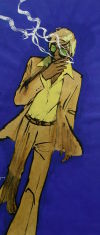
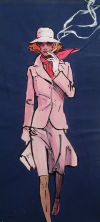 At the end of the 1950s Gerd Grimm entered a business relationship which secured him a continuous income for the next 23 years, up until the early 80s. During this time he was in charge of the graphic design for the cigarette brand “Reval”, manufactured in Lahr In this setting he succeeded in portraying people, individuals, and situations of modern urban life as brilliantly as he had done in his freelance work and transporting them into the new consumer atmosphere of smokers. It is striking how easily Grimm adapted to new trends and tendencies without giving up his distinctive style. Towards the end of the 60s the Reval colours blue and yellow-orange proved to be ideal for integrating pop art elements.
At the end of the 1950s Gerd Grimm entered a business relationship which secured him a continuous income for the next 23 years, up until the early 80s. During this time he was in charge of the graphic design for the cigarette brand “Reval”, manufactured in Lahr In this setting he succeeded in portraying people, individuals, and situations of modern urban life as brilliantly as he had done in his freelance work and transporting them into the new consumer atmosphere of smokers. It is striking how easily Grimm adapted to new trends and tendencies without giving up his distinctive style. Towards the end of the 60s the Reval colours blue and yellow-orange proved to be ideal for integrating pop art elements.
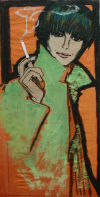 Girls and young men with blue faces or green hair are not uncommon at this stage in his work. He also experimented with collage techniques and used them as a background for his ink drawings or artfully combined both. Several times his Reval posters were voted among the top ten works of art of the year.
Girls and young men with blue faces or green hair are not uncommon at this stage in his work. He also experimented with collage techniques and used them as a background for his ink drawings or artfully combined both. Several times his Reval posters were voted among the top ten works of art of the year.
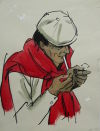 In April 1963 The journal “Commercial Art” wrote: “a shining star in the sky of advertising….” But there were certain aspects, which Grimm refused to discuss. He never “corrected” a drawing. Either it was perfect or it was no use whatever. The subject dashed off in one stroke had to be the final version. In fact, Grimm always understood his drawings as documenting the “Zeitgeist”. He was convinced that people change their way of moving and behaving every two years at the latest. This view of life and time influenced his genius: he showed great skills in only hinting at situations, omitting details or even leaving blanks for the viewer to fill in.
In April 1963 The journal “Commercial Art” wrote: “a shining star in the sky of advertising….” But there were certain aspects, which Grimm refused to discuss. He never “corrected” a drawing. Either it was perfect or it was no use whatever. The subject dashed off in one stroke had to be the final version. In fact, Grimm always understood his drawings as documenting the “Zeitgeist”. He was convinced that people change their way of moving and behaving every two years at the latest. This view of life and time influenced his genius: he showed great skills in only hinting at situations, omitting details or even leaving blanks for the viewer to fill in.
World tours and human circumstances
 Thanks to the continuous Reval commissions Grimm’s economic situation became quite comfortable, which from the mid-sixties onwards allowed him to travel all around the world. Very often he came back to the USA, especially to New York, where he had already lived for five years of his life. It is not exaggerating to claim he was a New York junkie. The breath of this city, the noise, the smell, the atmosphere fascinated Grimm all through his life. But he also visited California, Alaska, Antigua, South America, South Africa, and the Far East. The result of all these journeys was hundreds of graphics. Although most of these have never been published, these graphics are certainly among his most intense and expressive works.
Thanks to the continuous Reval commissions Grimm’s economic situation became quite comfortable, which from the mid-sixties onwards allowed him to travel all around the world. Very often he came back to the USA, especially to New York, where he had already lived for five years of his life. It is not exaggerating to claim he was a New York junkie. The breath of this city, the noise, the smell, the atmosphere fascinated Grimm all through his life. But he also visited California, Alaska, Antigua, South America, South Africa, and the Far East. The result of all these journeys was hundreds of graphics. Although most of these have never been published, these graphics are certainly among his most intense and expressive works.
They show and they prove that Gerd Grimm was a citizen of the world and a sensitive observer of human circumstances, not only taking in the sunny side of life, but also showing concern for the dark side. Grimm had what can be called a ‘social eye’. He drew streams of passengers in the subway exit, dustbins in courtyards, street-musicians, suburb-bars and neon ad-signs, he portrayed slums in Bolivia or skylines of American mega-cities, he documented the hopelessness of black youngsters in Johannesburg or Antigua as well as the abundance of a deserted village in Alaska – all this with the same spirit of truth.
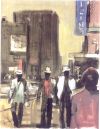
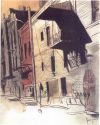 In his drawings it was Grimm’s concern to show the conditions of the modern human being in his search for contact, his loneliness. Thus, the vibrant atmosphere of huge cities such as New York with its millions of inhabitants offered him the opportunity to capture people’s loneliness, anonymity and speechlessness in their postures, gestures, and expressions. Gerd Grimm lived a quiet secluded life, but as an artist he was always a citizen of the world.
In his drawings it was Grimm’s concern to show the conditions of the modern human being in his search for contact, his loneliness. Thus, the vibrant atmosphere of huge cities such as New York with its millions of inhabitants offered him the opportunity to capture people’s loneliness, anonymity and speechlessness in their postures, gestures, and expressions. Gerd Grimm lived a quiet secluded life, but as an artist he was always a citizen of the world.
Gerd Grimm died in Freiburg in 1998. Ten years after his death, it is time to discover him.
